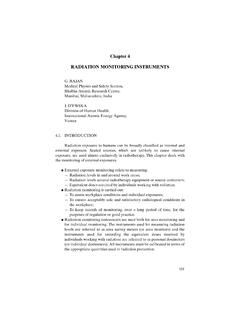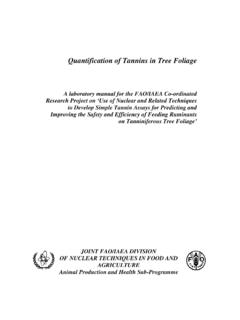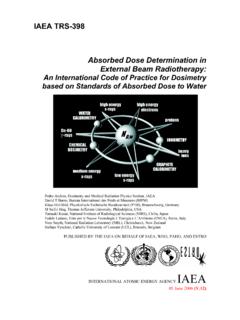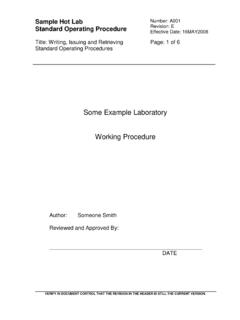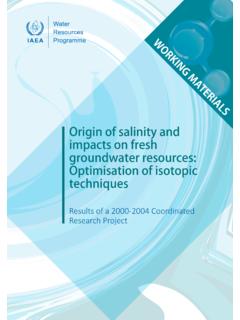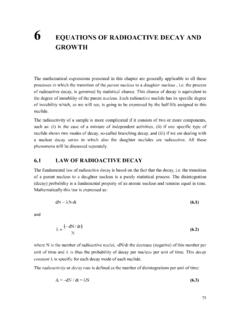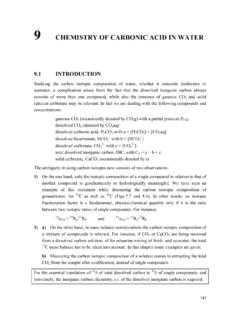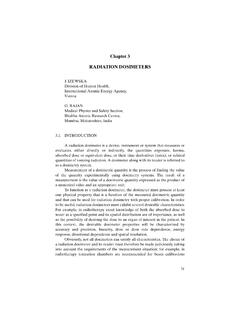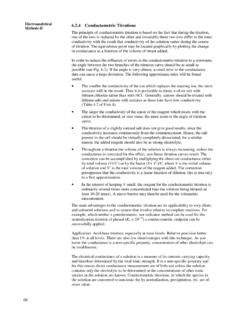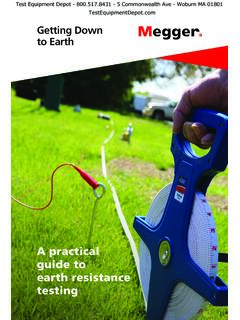Transcription of Chapter 9: Calibration of Photon and Electron Beams
1 IAEA International Atomic Energy Agency Set of 189 slides based on the Chapter authored by P. Andreo, Seuntjens, and Podgorsak of the IAEA publication (ISBN 92-0-107304-6): Radiation Oncology Physics: A Handbook for Teachers and Students Objective: To familiarize the student with the basic principles of radiation dosimetry. Chapter 9: Calibration of Photon and Electron Beams Slide set prepared in 2006 by Podgorsak (Montreal, McGill University) Comments to S. Vatnitsky: Version 2012 IAEA Radiation Oncology Physics: A Handbook for Teachers and Students - 9. Chapter 9. TABLE OF CONTENTS Introduction Ionization chamber based dosimetry Corrections for influence quantities Determination of dose using calibrated chambers Stopping power ratios Mass-energy absorption coefficient ratios Perturbation correction factors Beam quality specification Calibration of MV Photon and Electron Beams Kilovoltage dosimetry Error and uncertainties analysis IAEA Radiation Oncology Physics: A Handbook for Teachers and Students - Slide 1 INTRODUCTION Modern radiotherapy relies on accurate dose delivery to the prescribed target volume.
2 ICRU recommends an overall accuracy in tumour dose delivery of 5 %, based on: An analysis of dose response data. An evaluation of errors in dose delivery in a clinical setting. Considering all uncertainties involved in the dose delivery to the patient, the 5 % accuracy is by no means easy to attain. IAEA Radiation Oncology Physics: A Handbook for Teachers and Students - Slide 2 INTRODUCTION Accurate dose delivery to the target with external Photon or Electron Beams is governed by a chain consisting of the following main links: Basic output Calibration of the beam Procedures for measuring the relative dose data. Equipment commissioning and quality assurance.
3 Treatment planning Patient set-up on the treatment machine. IAEA Radiation Oncology Physics: A Handbook for Teachers and Students - Slide 3 INTRODUCTION The basic output for a clinical beam is usually stated as: Dose rate for a point P in G/min or Gy/MU. At a reference depth zref (often the depth of dose maximum zmax). In a water phantom for a nominal source to surface distance (SSD) or source to axis distance (SAD). At a reference field size on the phantom surface or the isocentre (usually 10 10 cm2). IAEA Radiation Oncology Physics: A Handbook for Teachers and Students - Slide 4 INTRODUCTION Machine basic output is usually given in: Gy/min for kilovoltage x-ray generators and teletherapy units.
4 Gy/MU for clinical linear accelerators. For superficial and orthovoltage Beams and occasionally for Beams produced by teletherapy machines, the basic beam output may also be stated as the air kerma rate in air (in Gy/min) at a given distance from the source and for a given nominal collimator or applicator setting. IAEA Radiation Oncology Physics: A Handbook for Teachers and Students - Slide 5 INTRODUCTION Basic output Calibration for Photon and Electron Beams is carried out with: Radiation dosimeters Special dosimetry techniques. Radiation dosimetry refers to a determination by measurement and/or calculation of: Absorbed dose or Some other physically relevant quantity, such as air kerma, fluence or equivalent dose at a given point in the medium.
5 IAEA Radiation Oncology Physics: A Handbook for Teachers and Students - Slide 6 INTRODUCTION Radiation dosimeter is defined as any device that is capable of providing a reading M that is a measure of the dose D deposited in the dosimeter s sensitive volume V by ionizing radiation. Two categories of dosimeters are known: Absolute dosimeter produces a signal from which the dose in its sensitive volume can be determined without requiring Calibration in a known radiation field. Relative dosimeter requires Calibration of its signal in a known radiation field. IAEA Radiation Oncology Physics: A Handbook for Teachers and Students - Slide 7 INTRODUCTION Basic output Calibration of a clinical radiation beam, by virtue of a direct determination of dose or dose rate in water under specific reference conditions, is referred to as reference dosimetry.
6 Three types of reference dosimetry technique are known: Calorimetry Fricke (chemical, ferrous sulfate) dosimetry Ionization chamber dosimetry IAEA Radiation Oncology Physics: A Handbook for Teachers and Students - Slide 1 INTRODUCTION Calorimetry Calorimetry is the most fundamental of the three reference dosimetry techniques, since it relies on basic definition of either electrical energy or temperature. In principle, calorimetric dosimetry is simple. In practice, calorimetric dosimetry is very complex because of the need for measuring extremely small temperature differences. This relegates the calorimetric dosimetry to sophisticated standards laboratories.
7 IAEA Radiation Oncology Physics: A Handbook for Teachers and Students - Slide 2 INTRODUCTION Calorimetry Main characteristics of calorimetry dosimetry: Energy imparted to matter by radiation causes an increase in temperature Dose absorbed in the sensitive volume is proportional to is measured with thermocouples or thermistors. Calorimetric dosimetry is the most precise of all absolute dosimetry techniques. T. T. TIAEA Radiation Oncology Physics: A Handbook for Teachers and Students - Slide 3 INTRODUCTION Calorimetry The following simple relationship holds: is the average dose in the sensitive volume is the thermal capacity of the sensitive volume is the thermal defect is the temperature increase Note: D dEdm Cp T1 D Cp T T(water, 1 Gy) 10 4 KIAEA Radiation Oncology Physics: A Handbook for Teachers and Students - Slide 4 INTRODUCTION Calorimetry Two types of absorbed dose calorimeter are currently used in standards laboratories.
8 In graphite calorimeters the average temperature rise is measured in a graphite body that is thermally insulated from surrounding bodies (jackets) by evacuated vacuum gaps. In sealed water calorimeters use is made of the low thermal diffusivity of water, which enables the temperature rise to be measured directly at a point in continuous water. IAEA Radiation Oncology Physics: A Handbook for Teachers and Students - Slide 1 INTRODUCTION Fricke (chemical) dosimetry Ionizing radiation absorbed in certain media produces a chemical change in the media and the amount of this chemical change in the absorbing medium may be used as a measure of absorbed dose.
9 The best known chemical radiation dosimeter is the Fricke dosimeter which relies on oxidation of ferrous ions into ferric ions in an irradiated ferrous sulfate FeSO4 solution. (Fe2 ) (Fe3 )IAEA Radiation Oncology Physics: A Handbook for Teachers and Students - Slide 2 INTRODUCTION Fricke (chemical) dosimetry Concentration of ferric ions increases proportionally with dose and is measured with absorption of ultraviolet light (304 nm) in a spectrophotometer. Fricke dosimetry depends on an accurate knowledge of the radiation chemical yield of ferric ions. The radiation chemical yield G of ferric ions is measured in moles produced per 1 J of energy absorbed in the solution.
10 IAEA Radiation Oncology Physics: A Handbook for Teachers and Students - Slide 3 INTRODUCTION Fricke (chemical) dosimetry An accurate value of the chemical yield G is difficult to ascertain because the chemical yield is affected by: Energy of the radiation Dose rate Temperature of the solution during irradiation and readout. The chemical yield in mole/J is related to an older parameter, the G value in molecules of per 100 eV of absorbed energy: G(Fe3 ) Fe3 41 molecule/J 10 mol/J IAEA Radiation Oncology Physics: A Handbook for Teachers and Students - Slide 4 INTRODUCTION Fricke (chemical) dosimetry Average absorbed dose in a Fricke solution is given as: is the change in molar concentration of is the density of the Fricke solution.
